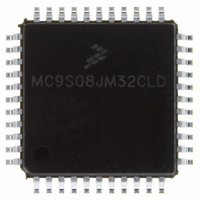MC9S08JM32CLD Freescale Semiconductor, MC9S08JM32CLD Datasheet - Page 199

MC9S08JM32CLD
Manufacturer Part Number
MC9S08JM32CLD
Description
IC MCU 8BIT 32K FLASH 44-LQFP
Manufacturer
Freescale Semiconductor
Series
HCS08r
Datasheet
1.MC9S08JM32CLD.pdf
(388 pages)
Specifications of MC9S08JM32CLD
Core Processor
HCS08
Core Size
8-Bit
Speed
48MHz
Connectivity
I²C, LIN, SCI, SPI, USB
Peripherals
LVD, POR, PWM, WDT
Number Of I /o
33
Program Memory Size
32KB (32K x 8)
Program Memory Type
FLASH
Ram Size
2K x 8
Voltage - Supply (vcc/vdd)
2.7 V ~ 5.5 V
Data Converters
A/D 8x12b
Oscillator Type
External
Operating Temperature
-40°C ~ 85°C
Package / Case
44-LQFP
Processor Series
S08JM
Core
HCS08
Data Bus Width
8 bit
Data Ram Size
2 KB
Interface Type
SCI/SPI
Maximum Clock Frequency
24 MHz
Number Of Programmable I/os
33
Number Of Timers
8
Maximum Operating Temperature
+ 85 C
Mounting Style
SMD/SMT
3rd Party Development Tools
EWS08
Development Tools By Supplier
DEMOJM, DEMOJMSKT, DEMOFLEXISJMSD, DEMO9S08JM16
Minimum Operating Temperature
- 40 C
On-chip Adc
8-ch x 12-bit
Lead Free Status / RoHS Status
Lead free / RoHS Compliant
Eeprom Size
-
Lead Free Status / Rohs Status
Lead free / RoHS Compliant
Available stocks
Company
Part Number
Manufacturer
Quantity
Price
Company:
Part Number:
MC9S08JM32CLD
Manufacturer:
Freescale Semiconductor
Quantity:
1 948
Company:
Part Number:
MC9S08JM32CLD
Manufacturer:
Freescale Semiconductor
Quantity:
10 000
- Current page: 199 of 388
- Download datasheet (5Mb)
To change from FEI clock mode to FBI clock mode, follow this procedure:
12.5.2
When switching between operational modes of the MCG, certain configuration bits must be changed in
order to properly move from one mode to another. Each time any of these bits are changed (PLLS, IREFS,
CLKS, or EREFS), the corresponding bits in the MCGSC register (PLLST, IREFST, CLKST, or
OSCINIT) must be checked before moving on in the application software.
Additionally, care must be taken to ensure that the reference clock divider (RDIV) is set properly for the
mode being switched to. For instance, in PEE mode, if using a 4 MHz crystal, RDIV must be set to %001
(divide-by-2) or %010 (divide -by-4) in order to divide the external reference down to the required
frequency between 1 and 2 MHz.
The RDIV and IREFS bits should always be set properly before changing the PLLS bit so that the FLL or
PLL clock has an appropriate reference clock frequency to switch to.
Freescale Semiconductor
3. After the proper configuration bits have been set, wait for the affected bits in the MCGSC register
1. Change the CLKS bits to %01 so that the internal reference clock is selected as the system clock
2. Wait for the CLKST bits in the MCGSC register to change to %01, indicating that the internal
to be changed appropriately, reflecting that the MCG has moved into the proper mode.
— If ERCLKEN was set in step 1 or the MCG is in FEE, FBE, PEE, PBE, or BLPE mode, and
— If in FEE mode, check to make sure the IREFST bit is cleared and the LOCK bit is set before
— If in FBE mode, check to make sure the IREFST bit is cleared, the LOCK bit is set, and the
source.
reference clock has been appropriately selected.
minimum power consumption, leave the internal reference disabled while in an external clock
mode.
EREFS was also set in step 1, wait here for the OSCINIT bit to become set indicating that the
external clock source has finished its initialization cycles and stabilized. Typical crystal startup
times are given in Appendix A, “Electrical Characteristics”.
moving on.
CLKST bits have changed to %10 indicating the external reference clock has been
appropriately selected. Although the FLL is bypassed in FBE mode, it is still on and will lock
in FBE mode.
MCG Mode Switching
MC9S08JM60 Series Data Sheet, Rev. 3
Multi-Purpose Clock Generator (S08MCGV1)
199
Related parts for MC9S08JM32CLD
Image
Part Number
Description
Manufacturer
Datasheet
Request
R
Part Number:
Description:
Manufacturer:
Freescale Semiconductor, Inc
Datasheet:
Part Number:
Description:
Manufacturer:
Freescale Semiconductor, Inc
Datasheet:
Part Number:
Description:
Manufacturer:
Freescale Semiconductor, Inc
Datasheet:
Part Number:
Description:
Manufacturer:
Freescale Semiconductor, Inc
Datasheet:
Part Number:
Description:
Manufacturer:
Freescale Semiconductor, Inc
Datasheet:
Part Number:
Description:
Manufacturer:
Freescale Semiconductor, Inc
Datasheet:
Part Number:
Description:
Manufacturer:
Freescale Semiconductor, Inc
Datasheet:
Part Number:
Description:
Manufacturer:
Freescale Semiconductor, Inc
Datasheet:
Part Number:
Description:
Manufacturer:
Freescale Semiconductor, Inc
Datasheet:
Part Number:
Description:
Manufacturer:
Freescale Semiconductor, Inc
Datasheet:
Part Number:
Description:
Manufacturer:
Freescale Semiconductor, Inc
Datasheet:
Part Number:
Description:
Manufacturer:
Freescale Semiconductor, Inc
Datasheet:
Part Number:
Description:
Manufacturer:
Freescale Semiconductor, Inc
Datasheet:
Part Number:
Description:
Manufacturer:
Freescale Semiconductor, Inc
Datasheet:
Part Number:
Description:
Manufacturer:
Freescale Semiconductor, Inc
Datasheet:











